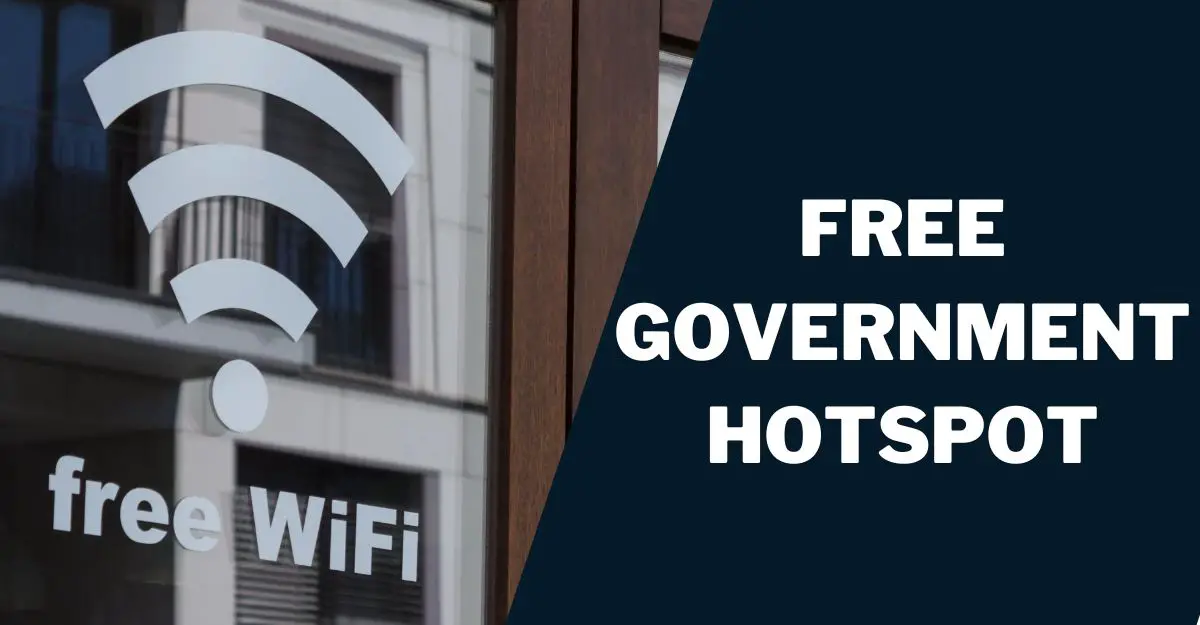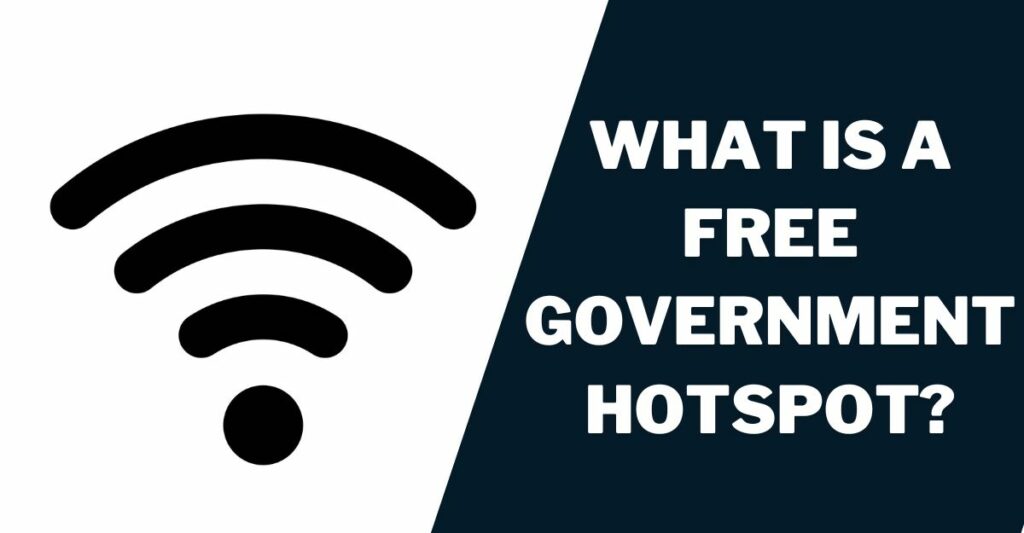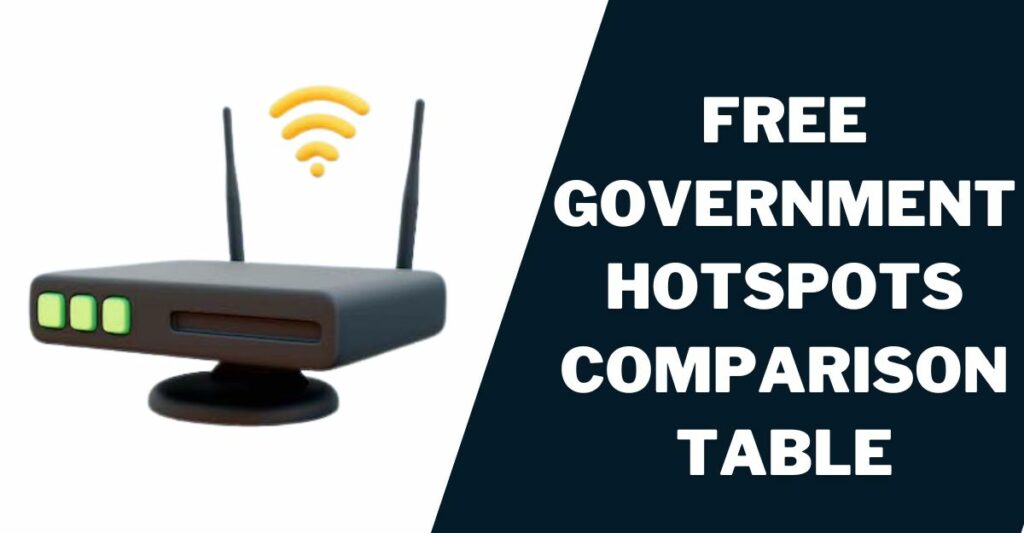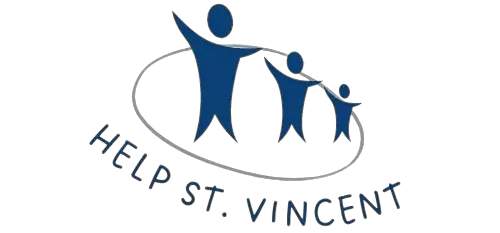Free Government Hotspot: Top 5 Providers & How to Get

I was perched at my favorite café corner, coffee growing cold, with a deadline breathing down my neck.
Just then, my internet connection went AWOL.
That’s when my friend informed me about the Government offering Hotspots for free.
In this article, I explain the ins and outs of the Free Government Hotspot program and how you can get it for yourself.
What is a Free Government Hotspot?

A free Government hotspot is a wireless internet access point provided by the Government for free to eligible low income individuals and families.
Are you a student at any level? You won’t want to miss my previous post on a Free Hotspot for Students and enjoy seamless learning on the go.
Top 5 Free Government Hotspot Locations
These are the top 5 Free Government Hotspot Locations:
1. Public Libraries
Public libraries provide government hotspots. These locations offer multiple hotspots, ensuring you find an uncrowded one.
2. Community Centers
Community centers are excellent spots for government hotspots. They usually have hotspots in common areas like lobbies or computer labs.
3. Schools
Schools often grant government hotspots for students, staff, and visitors. Some schools even provide them in classrooms and shared spaces.
4. Parks and Recreation Centers
Parks and recreation centers include government hotspots in their WiFi services.
5. Government Buildings
Certain government buildings (like post offices, city halls, and community centers) offer complimentary government hotspots.
You can also get one under the affordable connectivity program. Check out my post on Free ACP Hotspot to learn more.
Top 5 Free Government Hotspot Providers
These are the Top 5 Free Government Hotspot Providers:
1. T Mobile
T Mobile offers qualified households a cost free mobile hotspot option via the Affordable Connectivity Program (ACP). These hotspots operate within T Mobile’s network and offer a monthly data allowance of up to 10GB.
T Mobile is also giving out phones with 5g networks free of charge. Check my post on Free 5G Phone T Mobile to discover how to go about it.
2. Verizon
Verizon provides eligible households with a complimentary mobile hotspot through the Affordable Connectivity Program (ACP). These hotspots utilize Verizon’s network and feature a monthly data allocation of up to 6GB.
3. Comcast Xfinity
Comcast Xfinity introduces a no cost internet service for qualifying households as part of the Internet Essentials initiative. This offering encompasses 100 Mbps download and 10 Mbps upload speeds and includes a free modem and router.
You can also get a free phone from Xfinity. Check my post on Xfinity Free Phone to discover how to go about it.
4. AT&T
AT&T offers eligible households a no cost mobile hotspot option via the Affordable Connectivity Program (ACP). These hotspots function on AT&T’s network and offer a monthly data allowance of up to 10GB.
My post on AT&T iPhone 12 Free reveals how you can get an iPhone from AT&T Freely.
5. Sprint
Sprint extends a complimentary mobile hotspot opportunity to eligible households through the Affordable Connectivity Program (ACP).
These hotspots operate on Sprint’s network and offer a monthly data allocation of up to 5GB.
Learn How to Get Free Wifi at Home Without Internet and stay connected effortlessly.
Free Government Hotspots Comparison Table

This table compares the Free Government Hotspots:
| Provider | Network | Data allowance | Eligibility | Cost | Speed |
|---|---|---|---|---|---|
| 50:5000 Mbps download, between 50: 500 Mbps upload | T Mobile | Depends on program | Household income at or below 200% of the federal poverty level | Free | 50:5000 Mbps download, between 50: 500 Mbps upload |
| Verizon | Verizon | Depends on program | Household income at or below 200% of the federal poverty level | Free | 517.37 Mbps: 2,314.62 Mbps download, between 910.82 Mbps: 2,016.88 Mbps Mbps upload |
| Comcast Xfinity | Internet Essentials | Depends on program | Household income at or below 200% of the federal poverty level | Free | 400:1,200 Mbps download, 10:35Mbps Mbps upload |
| AT&T | AT&T | Depends on program | Household income at or below 200% of the federal poverty level | Free | 400:1,200 Mbps download, 10:35Mbps Mbps upload |
| Sprint | Sprint | Depends on program | Household income at or below 200% of the federal poverty level | Free | 4 35 Mbps Mbps download, between 1 5 Mbps Mbps upload |
If you’re interested in more ways the government is bridging the digital divide, don’t miss our piece on Free Wifi with Food Stamps.
How to Find Free Government Hotspots Near Me
Follow these steps to find Free Government Hotspots Near Me:
- Check with your local library: Many libraries offer free WiFi hotspots you can borrow for a certain period.
- Contact your local community center: Community centers often have free WiFi hotspots that you can use.
- Ask your school district: Some school districts offer free WiFi hotspots to students and staff.
- Search online: Several websites list them in different areas.
- Contact your state or local government: Your state or county government may have a program that provides free WiFi hotspots to low income families.
Also, check my post on Free Government Internet and Laptop programs to explore the realm of bridging the digital divide.
How to Get a Free Unlimited Hotspot on My Phone?
Follow these steps to get Free Unlimited Hotspot on your phone:
- Take Advantage of Government Programs: Numerous government initiatives provide cost free or affordable hotspot options to low income households. For instance, the Affordable Connectivity Program (ACP) extends eligible households a $30 internet service discount.
- Use a Mobile Virtual Network Operator (MVNO): MVNOs, smaller firms that lease network capacity from major carriers like AT&T, Verizon, and T Mobile, often present more budget friendly hotspot plans than prominent carriers.
- Sign up For a Promo Offer: Many carriers propose temporary free or low cost hotspot plans through promotional deals. Carefully review terms and conditions to avoid hidden charges or limitations before enrolling.
- Use a WiFi Hotspot App: Accessing local free WiFi networks becomes convenient through various WiFi hotspot apps. These apps offer an economical means to manage hotspot usage effectively.
Discover how you can also get Free Internet with Food Stamps, blending connectivity with essential assistance.
Eligibility Criteria
These are the Eligibility Criteria to Get free Government Hotspot:
- Your household income is equal to or less than 200% of the federal poverty level.
- You participate in specific government assistance programs like Medicaid, SNAP, or WIC.
- You reside in a low income area.
- You are a student.
- You are a part of designated groups, such as veterans or individuals with disabilities.
Documents Required
These are the Documents Required to get a Free Government Hotspot:
- Proof of Income: Provide your latest pay stub, tax return, or a letter from your social services agency.
- Proof of Residency: Submit a copy of your lease agreement, utility bill, or official government ID.
- Proof of Household Size: Furnish a copy of your birth, marriage, or divorce certificate.
- Social Security Number: Mandatory for all applicants, irrespective of U.S. citizenship status.
How to Connect to a Free Government Hotspot Device
Follow these steps to Connect to a Free Government Hotspot Device:
- Locate the hotspot device: Hotspots are commonly found in public spots like libraries, community centers, schools, and even businesses like coffee shops and hotels.
- Turn on your device: If you’re using a laptop or tablet, switch it on and ensure it’s linked to WiFi. For smartphones, turn them on and disconnect them from any mobile data plans.
- Find the hotspot network name: The hotspot’s name will be visible on the hotspot device or among the available WiFi networks on your device.
- Enter the hotspot password: You’ll find the password on the hotspot device. If it’s not there, contact the program administrator.
- Connect to the hotspot network: After entering the password, tap or click the hotspot’s name to connect.
Is There an Unlimited Free Hotspot Device From Government?
Government provided hotspot devices do not offer unlimited data, they come with data limits. The amount of data you receive depends on the specific program you qualify for.
Benefits of Government Hotspots that Are Free
These are the benefits of government hotspots:
- Accessibility: They grant easy access to the internet, connecting you to vital information and resources.
- Cost Savings: These hotspots alleviate the need for costly internet subscriptions, saving you money.
- Education: They enable online learning, educational research, and skill enhancement, especially for students.
- Communication: Stay connected with family, friends, and important services through online communication.
- Information Access: Instantly access news, health information, government services, and more.
If you just want a hotspot device, check out how you can get a EBB Hotspot Device Free.
FAQs on Free Government Hotspot
These are the Frequently Asked Questions about Free Government Hotspot:
Are Government Hotspots Secure?
Free government hotspots are safe due to encryption shielding your data from unauthorized entry.
Can I Use Government Hotspots for Business Purposes?
You can use government hotspots for business purposes.
Are There Any Data Limits on Free Hotspots from the Government?
Government hotspots that are free have data limits.
Are Free Government Hotspots Available 24/7?
Some free hotspots from the government are available 24/7, while others are only available during certain hours.
Conclusion
In today’s connected world, a free government hotspot is a bridge to opportunity. They bring internet access to those who need it most, fostering education, job prospects, and communication. With various programs and locations, these hotspots ensure everyone can surf the digital wave anytime, anywhere.


